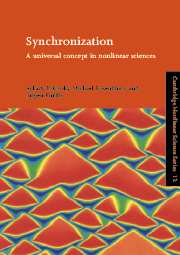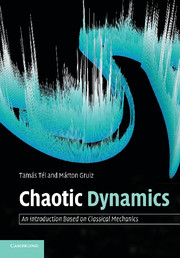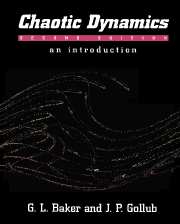Synchronization
First recognized in 1665 by Christiaan Huygens, synchronization phenomena are abundant in science, nature, engineering and social life. Systems as diverse as clocks, singing crickets, cardiac pacemakers, firing neurons and applauding audiences exhibit a tendency to operate in synchrony. These phenomena are universal and can be understood within a common framework based on modern nonlinear dynamics. The first half of this book describes synchronization without formulae, and is based on qualitative intuitive ideas. The main effects are illustrated with experimental examples and figures, and the historical development is outlined. The remainder of the book presents the main effects of synchronization in a rigorous and systematic manner, describing classical results on synchronization of periodic oscillators, and recent developments in chaotic systems, large ensembles, and oscillatory media. This comprehensive book will be of interest to a broad audience, from graduate students to specialist researchers in physics, applied mathematics, engineering and natural sciences.
- The first specialised book on synchronization available in English
- Presented at both a qualitative and experimentally oriented level
- Combines description of classical effects with presentation of recent developments
Reviews & endorsements
"This attractively laid-out book contains numerous fascinating examples of synchronization culled from the physical and biological sciences...The book concludes with one of the best expositions on the synchronization of chaotic systems that I have read...Clearly, the authors...have pulled off a very difficult trick, that of writing a book that is both a definitive introduction to synchronization for the casual reader and a definitive text for researchers working in a variety of fields." Nature
"This book will be of use to anybody interested or working in the field. It should find its place on the shelves of many science libraries because it supplies sufficient resources to both the layperson and the specialist." Pure Applicational Geophysics
"This book includes bountiful examples...Synchronization is most suited...for graduate students in the sciences, engineering or mathematics and other scientists who want to learn about this exciting and rapidly developing field." Rober C. Hilborn, American Association of Physics Teachers
"Synchronization is the first book to treat this subject in a unified fashion...an unconventional but excellent pedagogical choice...the treatment of the fundamentals is very well done and more readable than much of the original literature on this still-fashionable subject." Physics Today January 2003
"This book will be of use to anybody interested or working in the field. It should find its place on the shelves of many science libraries because it supplies sufficient resources to both the layperson and the specialist." Pure Applicational Geophysics
Product details
May 2003Paperback
9780521533522
432 pages
243 × 170 × 24 mm
0.68kg
222 b/w illus.
Available
Table of Contents
- Preface
- 1. Introduction
- Part I. Synchronization Without Formulae:
- 2. Basic notions: the self-sustained oscillator and its phase
- 3. Synchronization of a periodic oscillator by external force
- 4. Synchronization of two and many oscillators
- 5. Synchronization of chaotic systems
- 6. Detecting synchronization in experiments
- Part II. Phase Locking and Frequency Entrainment:
- 7. Synchronization of periodic oscillators by periodic external action
- 8. Mutual synchronization of two interacting periodic oscillators
- 9. Synchronization in the presence of noise
- 10. Phase synchronization of chaotic systems
- 11. Synchronization in oscillatory media
- 12. Populations of globally coupled oscillators
- Part III. Synchronization of Chaotic Systems:
- 13. Complete synchronization I: basic concepts
- 14. Complete synchronization II: generalizations and complex systems
- 15. Synchronization of complex dynamics by external forces
- Appendix 1. Discovery of synchronization by Christiaan Huygens
- Appendix 2. Instantaneous phase and frequency of a signal
- References
- Index.






